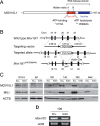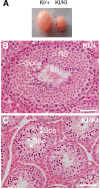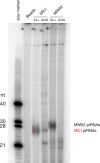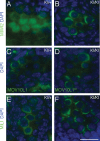Mutations in the MOV10L1 ATP Hydrolysis Motif Cause piRNA Biogenesis Failure and Male Sterility in Mice
- PMID: 27655786
- PMCID: PMC5178147
- DOI: 10.1095/biolreprod.116.142430
Mutations in the MOV10L1 ATP Hydrolysis Motif Cause piRNA Biogenesis Failure and Male Sterility in Mice
Abstract
Piwi-interacting RNAs (piRNAs) are a class of small non-coding RNAs. piRNAs protect the genome integrity of the germline by silencing active transposable elements and are essential for germ cell development. Most piRNA pathway proteins are evolutionarily conserved. MOV10L1, a testis-specific RNA helicase, binds to piRNA precursors and is a master regulator of piRNA biogenesis in mouse. Here we report that mutation of the MOV10L1 ATP hydrolysis site leads to depletion of piRNAs on Piwi proteins, de-repression of transposable elements, and conglomeration of piRNA pathway proteins into polar granules. The Mov10l1 mutant mice exhibit meiotic arrest and male sterility. Our results show that mutation of the MOV10L1 ATP hydrolysis site perturbs piRNA biogenesis.
Keywords: MOV10L1; Male infertility; Meiosis; Retrotansposon; piRNA.
Copyright 2016 by The Society for the Study of Reproduction.
Figures






References
-
- Aravin AA, Naumova NM, Tulin AV, Vagin VV, Rozovsky YM, Gvozdev VA. Double-stranded RNA-mediated silencing of genomic tandem repeats and transposable elements in the D. melanogaster germline. Curr Biol. 2001;11:1017–1027. - PubMed
-
- Aravin A, Gaidatzis D, Pfeffer S, Lagos-Quintana M, Landgraf P, Iovino N, Morris P, Brownstein MJ, Kuramochi-Miyagawa S, Nakano T, Chien M, Russo JJ, et al. A novel class of small RNAs bind to MILI protein in mouse testes. Nature. 2006;442:203–207. - PubMed
-
- Girard A, Sachidanandam R, Hannon GJ, Carmell MA. A germline-specific class of small RNAs binds mammalian Piwi proteins. Nature. 2006;442:199–202. - PubMed
Grants and funding
LinkOut - more resources
Full Text Sources
Other Literature Sources
Molecular Biology Databases

